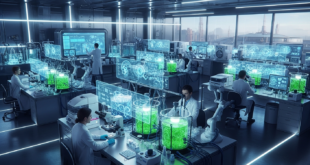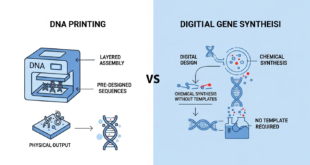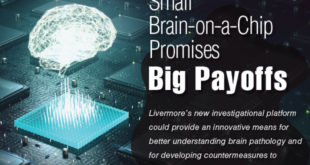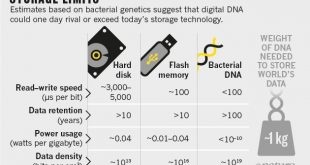The Biocyborg Age: Reprogramming Life for a Resilient Future
Explore how CRISPR and synthetic biology are creating self-healing humans, adaptive organs, and environmental solutions in the age of biocybers.
Introduction: Beyond Cyborgs to Biological Rebirth
We stand at the precipice of a new era in human evolution, where the lines between biology and technology dissolve. No longer confined to mechanical limbs or external implants, humanity is entering the biocyborg age—a paradigm where synthetic biology and CRISPR gene editing enable us to reprogram our DNA, merge with machines at the cellular level, and engineer organisms that heal, adapt, and evolve. From soldiers with radiation-resistant cells to paralyzed individuals controlling robotic limbs via neural lace, the fusion of biology and technology is redefining what it means to be human.
1. From Cyborgs to Biocyborgs: A Revolutionary Leap
Cyborgs: The Mechanical Foundations
Traditional cyborgs—cybernetic organisms—integrate hardware with human biology to restore or enhance function. Cochlear implants, for instance, convert sound into electrical signals for the deaf, while brain-computer interfaces (BCIs) like Neuralink’s implants enable paralyzed individuals to control devices via neural signals.
These technologies rely on external feedback systems, such as electrodes translating neural signals into robotic movements. For instance, cochlear implants convert sound waves into electrical signals, enabling the deaf to hear, while BCIs allow paralyzed individuals to control devices through neural activity. These innovations represent the first steps in merging human physiology with technology, focusing primarily on restoring lost functions or compensating for biological limitations.
Enhanced Cyborgs: Beyond Natural Limits
Enhanced cyborgs aim to surpass innate human capabilities. Retinal implants that detect infrared light, 3D-printed organs with embedded health sensors, and exoskeletons that amplify strength exemplify this shift. Unlike restorative tools, these technologies prioritize performance optimization, blurring the line between therapy and augmentation.
Biocyborgs: Biology as Technology
Biocyborgs represent a paradigm shift, integrating synthetic biology with cybernetics. Unlike conventional cyborgs, which attach external devices, biocyborgs embed technology at the cellular or genetic level.
Synthetic DNA circuits exemplify this shift, where engineered genes act as “biological software” to reprogram cells for tasks like producing insulin on demand or initiating tissue repair. Another breakthrough is the development of biohybrid organs, such as 3D-printed hearts embedded with nanosensors that monitor health metrics and release stem cells to regenerate damaged areas. Perhaps most intriguing are xenobots—living robots constructed from frog stem cells and designed using AI algorithms. These xenobots perform specialized functions like environmental toxin cleanup or targeted drug delivery, illustrating the fusion of biological matter with technological innovation. This evolution moves beyond repairing the human body to redesigning it, transitioning from fixing broken parts to rewriting the code of life itself.
2. CRISPR and Synthetic Biology: Tools of the Biocyborg Revolution
CRISPR: Precision Genetic Scissors
CRISPR-Cas9, a groundbreaking gene-editing tool, enables precise modifications to DNA with unprecedented accuracy. In 2023, the FDA approved the first CRISPR-based therapy for sickle cell disease, correcting mutations in blood cells to alleviate symptoms. Beyond medicine, CRISPR is revolutionizing fields like agriculture and environmental science. Researchers are exploring its potential to enhance human performance, such as editing the MSTN gene to boost muscle growth or modifying EPO to improve oxygen efficiency in soldiers. Environmental applications include engineering bacteria to break down microplastics or absorb carbon emissions, showcasing CRISPR’s versatility as a tool for both healing and innovation.
Synthetic Biology: Reprogramming Life
Synthetic biology treats biology as programmable code, allowing scientists to redesign organisms for specific purposes. By treating DNA as programmable code, researchers can redesign organisms to produce life-saving drugs, clean environmental pollutants, or even store digital data. This field merges principles of engineering with the complexity of life, offering unprecedented control over biological processes. At the heart of this transformation lies CRISPR, a precision gene-editing tool that has democratized genetic manipulation, and the emerging concept of biocyborgs—hybrids of biology and technology that push the boundaries of human potential.
Modified yeast strains, for example, now produce rose oil for perfumes and spider silk for bulletproof fabrics, demonstrating how microbes can be transformed into living factories. In healthcare, synthetic biology enables the engineering of gut bacteria to synthesize vitamins or neutralize toxins, enhancing both digestion and immunity. MIT’s “cyborg stingrays,” hybrid creations combining rat heart cells with gold skeletons, blur the line between life and machine, offering insights into biohybrid systems. These advancements highlight the shift from passive mechanical integration to active biological redesign, where technology becomes inseparable from organic processes.
3. Applications: Healing, Enhancing, and Weaponizing Biology
Medical Breakthroughs
The medical potential of biocyborg technology is vast. Lab-grown liver organoids embedded with microchips now test drug toxicity in real time, reducing reliance on animal testing. Neural innovations like Synchron’s Stentrode—a blood vessel-implanted BCI—allow paralyzed patients to control computers through thought alone. Breakthroughs in regenerative medicine include robotic fingers sheathed in lab-grown human skin that autonomously repair minor cuts, hinting at future applications for burn victims or amputees. These technologies not only restore function but also push the boundaries of human resilience and longevity.
Climate and Industry
Biocyborg technologies also address environmental challenges. Synthetic algae engineered to sequester carbon at scale could mitigate climate change, while CRISPR-modified microbes produce sustainable materials like microbial leather. Companies such as Bolt Threads leverage these innovations to revolutionize industries, blending ecological responsibility with cutting-edge science.
Military and Ethical Frontiers
Synthetic biology is poised to transform military capabilities. Researchers explore editing genes like MSTN (which regulates muscle growth) to create soldiers with enhanced strength, or EPO (which controls red blood cell production) to boost endurance. Inspired by extremophiles like tardigrades, scientists aim to engineer human cells that repair radiation-induced DNA damage—a critical advantage in nuclear or space environments.
Military research explores biocyborg enhancements to create soldiers with superhuman endurance or radiation resistance, inspired by extremophiles like tardigrades. The human microbiome—a complex ecosystem of gut bacteria—is another frontier. Engineered probiotics could enhance soldiers’ digestion, immunity, or cognition. Conversely, adversaries might deploy pathogens to disrupt these microbial communities, inducing illness or counteracting enhancements. Such “microbiome warfare” underscores the dual-use potential of synthetic biology, where innovations designed to heal can also be weaponized.
However, ethical dilemmas abound. The 2018 CRISPR baby scandal, where genes were edited in human embryos, underscored risks like unintended mutations and heritable changes. Such controversies have prompted global calls for strict oversight, balancing innovation with ethical responsibility.
4. Risks: The Dark Side of Biological Engineering
Technical Perils
CRISPR’s precision is not infallible. Off-target edits—unintended genetic changes—risk triggering cancers or unintended traits. Mosaicism, where edits affect only some cells in embryos, complicates outcomes and raises safety concerns. Additionally, democratized tools like open-source DNA printers (e.g., BioBricks) could enable biohackers to engineer pathogens, posing bioterrorism risks.
Societal Threats
The rise of biocyborgs risks deepening societal divides. Genetic enhancements, accessible only to the wealthy, could create an augmented elite, exacerbating inequality. Neural data stored in cloud-connected BCIs might be hacked or exploited, threatening personal autonomy. Furthermore, heritable edits could irreversibly alter human genetics, with consequences for future generations. In response, the World Health Organization (WHO) has advocated for global governance frameworks, including registries for gene-editing trials, to ensure transparency and equity.
5. The Future: Merging Biology and AI
The fusion of biology and artificial intelligence is poised to revolutionize human resilience and adaptability. Self-evolving biocyborgs will harness AI-driven systems to continuously optimize their biological and synthetic components. Imagine adaptive organs like livers equipped with biosensors and machine-learning algorithms that dynamically adjust enzyme production in response to toxin exposure, effectively detoxifying the body in real time during environmental crises. These organs could communicate with external AI networks to preemptively address threats, such as neutralizing pollutants before they cause cellular damage.
Neural integration will blur the boundaries between human cognition and machine intelligence. Brain-computer interfaces (BCIs), enhanced by AI, could enable seamless language translation or instant access to global data repositories—effectively merging human thought with cloud-based knowledge. Projects like Neuralink’s brain-chip trials hint at a future where individuals “query” the internet through neural signals or collaborate with AI to solve complex problems. This symbiosis could redefine education, diplomacy, and creativity, as minds interface directly with artificial neural networks.
To combat climate change, living infrastructure will emerge as a cornerstone of sustainable design. Buildings coated in carbon-absorbing biofilms—engineered from synthetic algae or bacteria—could act as urban “lungs,” scrubbing greenhouse gases from the atmosphere. Meanwhile, advances in synthetic biology might enable extremophile humans to thrive in hostile environments. By integrating genes from Arctic fish or radiation-resistant tardigrades, humans could endure extreme cold, radiation, or oxygen-poor conditions, opening doors to interplanetary colonization or survival in climate-ravaged regions.
Yet these advancements demand ethical foresight. As biology becomes programmable, humanity must balance innovation with humility—ensuring that self-evolving biocyborgs and climate-resilient systems prioritize equity and ecological harmony over unchecked enhancement. The future of human-AI synergy lies not just in what we can engineer, but in how we steward this power to uplift both people and the planet.
Conclusion: Designing Humanity’s Next Chapter
The biocyborg age offers transformative potential—eradicating diseases, shielding soldiers from radiation, and mitigating climate disasters through engineered organisms. Yet, this power demands humility. Collaborative frameworks spanning science, ethics, and policy must ensure these technologies uplift humanity equitably. As we engineer evolution itself, the question shifts from “What can we build?” to “What should we become?”
Explore Further:
 International Defense Security & Technology Your trusted Source for News, Research and Analysis
International Defense Security & Technology Your trusted Source for News, Research and Analysis



